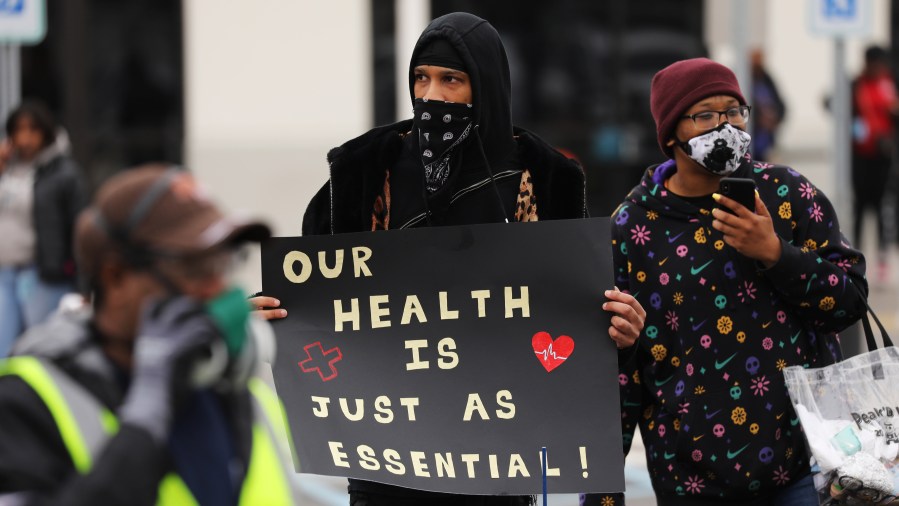This gig worker had to choose between work and her health

The people delivering groceries or restaurant takeout are considered essential workers, per regulation in states with lockdown orders and by definition for people who may be unable to go to grocery stores or prepare food because of illness, disability or age. But a lot of those delivery people are independent contractors, not employees. If they have their own health concerns and can’t do the job, they may not get paid at all.
This is the story of one delivery driver who decided to choose her own safety. The following is an edited transcript of her story.

I’m Kimberly James, and I live in Rome, Georgia. I’m like most drivers utilizing all the apps at the same time — doing Uber Eats, Lyft, DoorDash Grubhub and Postmates. They all kind of work about the same. You get a ping on the app, and you would accept it and go to the restaurant, pick up the food and then drive it to the customer’s house. Most of them are your general restaurants — McDonald’s, Taco Bell — down to your mom-and-pop restaurant.
Basically [I’m] leaving my house about 3 p.m. or 4 p.m., and then, a 12-hour shift, which usually would end up being, between gas and breaks, a 14- or 15-hour shift overnight. This is a really frustrating, difficult job for very low pay.
About a month ago, we had our first couple of [COVID-19] cases here, and they happened to be at a hospital that I deliver food to quite frequently. I had a nurse that was working the front desk of the ER order food, but she didn’t put that she was in the emergency room. I ended up walking through the hospital and then finding out that she was having me come to the emergency room where someone had been up there three times with the virus. That’s when I got scared for my life. Finally, I came home and I told my roommate, “I’m just going to have to sit here and not get paid. I can’t die for somebody’s milkshake or somebody’s hamburger.” I’m just hoping for anything at this point, like unemployment, anything, because I’ve been sitting here a month now with no pay coming in. I’ve exhausted every effort with every single one of those companies, and they’ve all told me no, unless I get a doctor’s note — and I can’t afford to go see a doctor.
I did apply for some working-from-home jobs, and I got hired with Amazon for Virtual Call Center, but I don’t get paid till about three weeks to a month from now. That’s all relying on if these workers at Amazon, that are striking right now, if they shut down those warehouses, then I won’t be able to start that job.

Related links: More insight from Molly Wood
The $2 trillion stimulus package passed by Congress last month expands unemployment benefits to gig workers, at least in theory. CNBC has a piece about how many states aren’t providing those benefits or don’t know how to implement them.
In response to strikes and demands from delivery drivers, Instacart has said it will start providing face masks, hand sanitizer and thermometers for its drivers, but stopped short of the hazard pay that striking workers have asked for. Meanwhile, Instacart said it would try to hire some 300,000 new workers to do shopping and delivery.
Also, Uber, whose drivers have seen demand plummet, has turned its app into a jobs board and listed openings at 7-11, McDonald’s and Amazon, according to the Financial Times. The company said it will connect drivers who have commercial licenses to logistics and freight companies. However, like most companies who rely on gig work that they don’t classify as employment, Uber is also not offering paid time off for drivers unless they are diagnosed with COVID-19 or ordered to quarantine.
The New York Times had a long story about Amazon workers and the company’s inconsistent policies around sick leave and worker protections, as well as the firing of a worker who led a strike at one of its warehouses. As it happens, The Wall Street Journal also has a story from Monday about all the other options for shopping online that aren’t Amazon, including a lot of small businesses that have far fewer logistics issues and could use the business.
The future of this podcast starts with you.
Every day, the “Marketplace Tech” team demystifies the digital economy with stories that explore more than just Big Tech. We’re committed to covering topics that matter to you and the world around us, diving deep into how technology intersects with climate change, inequity, and disinformation.
As part of a nonprofit newsroom, we’re counting on listeners like you to keep this public service paywall-free and available to all.
Support “Marketplace Tech” in any amount today and become a partner in our mission.











